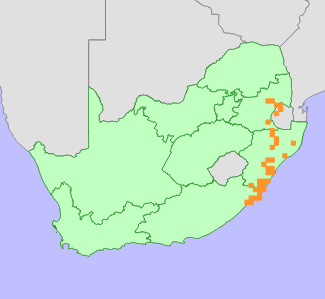|
Scientific Name | Senecio rhyncholaenus DC. |
Higher Classification | Dicotyledons |
Family | ASTERACEAE |
Synonyms | Senecio pseudo-rhyncholaenus Thell. var. auriculatus Thell. |
Common Names | Imfenyane (z), Mahoaneng (ss), Mahoanyana (ss), Reukbossie (a) |
National Status |
Status and Criteria | Least Concern |
Assessment Date | 2020/03/03 |
Assessor(s) | L. von Staden |
Justification | Senecio rhyncholaenus is a widespread and common species. It is declining across most of its range due to ongoing habitat loss and degradation, but is not yet in danger of extinction. |
Distribution |
Endemism | Not endemic to South Africa |
Provincial distribution | Eastern Cape, KwaZulu-Natal, Mpumalanga |
Range | This species is widespread across eastern South Africa, from the Mpumalanga Lowveld southwards through Zululand to the Pondoland coast at Port St Johns. It also occurs in eSwatini (Swaziland). |
Habitat and Ecology |
Major system | Terrestrial |
Major habitats | Dry Coast Hinterland Grassland, KwaZulu-Natal Hinterland Thornveld, Pondoland-Ugu Sandstone Coastal Sourveld, KwaZulu-Natal Coastal Belt Thornveld, Moist Coast Hinterland Grassland, Barberton Montane Grassland, KwaZulu-Natal Sandstone Sourveld, KwaZulu-Natal Coastal Belt Grassland, Transkei Coastal Belt, KaNgwane Montane Grassland, Northern Zululand Mistbelt Grassland, KwaZulu-Natal Highland Thornveld, Midlands Mistbelt Grassland, Northern Zululand Sourveld, Zululand Lowveld, Northern Escarpment Quartzite Sourveld, Ithala Quartzite Sourveld, Paulpietersburg Moist Grassland |
Description | It occurs in rocky outcrops on slopes in coastal grassland and woodland. |
Threats |
| About 45% of this species' habitat is irreversibly modified, mainly due to loss to agriculture, urban expansion, coastal development and rural settlements. It continues to be threatened across most of its range due to habitat degradation due to overgrazing. Some subpopulations are also threatened by competition from alien invasive plants. |
Population |
Population trend | Decreasing |
Assessment History |
Taxon assessed |
Status and Criteria |
Citation/Red List version | | Senecio rhyncholaenus DC. | Least Concern | Raimondo et al. (2009) | | Senecio rhyncholaenus DC. | Lower Risk - Least Concern | Scott-Shaw (1999) | |
Bibliography |
Hilliard, O.M. 1977. Compositae in Natal. University of Natal Press, Pietermaritzburg.
Raimondo, D., von Staden, L., Foden, W., Victor, J.E., Helme, N.A., Turner, R.C., Kamundi, D.A. and Manyama, P.A. 2009. Red List of South African Plants. Strelitzia 25. South African National Biodiversity Institute, Pretoria.
Scott-Shaw, C.R. 1999. Rare and threatened plants of KwaZulu-Natal and neighbouring regions. KwaZulu-Natal Nature Conservation Service, Pietermaritzburg.
|
Citation |
| von Staden, L. 2020. Senecio rhyncholaenus DC. National Assessment: Red List of South African Plants version 2024.1. Accessed on 2025/12/12 |
 Comment on this assessment
Comment on this assessment

